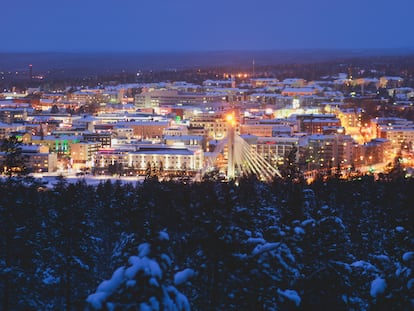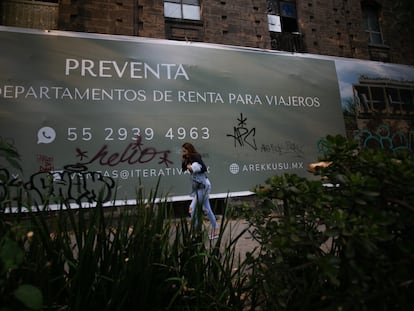How public housing can save 21st-century cities
In Austria, 25% of real estate is publicly owned and in Vienna nearly half of residents live in rental housing. EL PAÍS takes a trip through the history and geography of European social housing
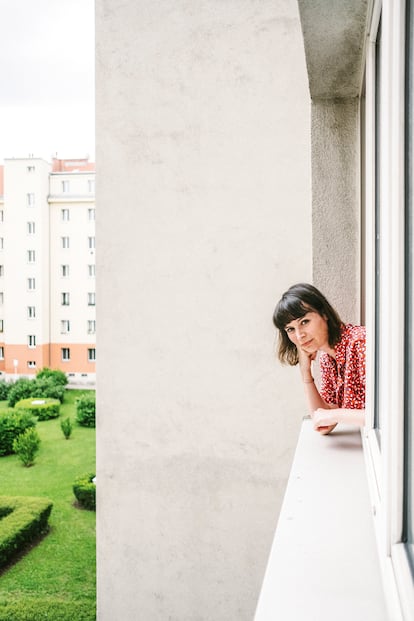
A light drizzle has emptied the balconies of the Karl-Marx-Hof in Vienna. This imposing structure — which consists of 1,275 apartments, inaugurated in 1930 — is the epitome of the municipal housing program of the Austrian capital, which began to take shape in 1919. This urban planning strategy was developed after the triumph of the Social Democratic Workers’ Party in the 1918 local elections. The period known as “Red Vienna,” during which the social democrats ran the city, lasted until 1934, although its influence still endures. The municipal administration provided the city with a series of publicly-owned flats.
Today, the Viennese municipal government is currently the largest owner of housing in Austria. As a result, the rental market in the Austrian capital is one of the most affordable in Europe, according to the annual housing index put out by Deloitte. At only €8.66 per square meter (or about $1 per square foot), this contrasts dramatically with the residential rental prices in cities such as Paris, London, Barcelona or Munich, where prices per square foot are more than double.
Barbara Schubert, 38, lives in one of these publicly owned apartments. “Here, it’s called a gemeindebau (community building),” she explains. Like her, around 50% of Viennese enjoy subsidized rent. They reside either in one of the 220,000 municipal homes, or in one of the 200,000 apartments built by cooperatives that have received public subsidies, according to statistics from the local government.
Schubert works as a German and French teacher at a secondary school in this city of 1.8 million inhabitants. Her rent is about €450 ($500) a month, without utilities. “Thanks to this, I’ve had more opportunities,” she notes. Schubert invests around 25% of her income into housing. She explains that, despite high inflation — which stood at around 8.5% in Austria in 2022 — neither she nor her friends (nor the majority of Viennese) have been forced to leave their homes for more affordable ones in the face of a rampant rise in rent.
“In the gemeindebau, they try to keep the inhabitants in the flats. If someone has problems with [public rental prices], they wouldn’t stand a chance in the free market,” she jokes. To be a beneficiary of public housing, you must pass an admission process that can last up to two years. It’s hard to get a rental contract. Schubert has lived in this apartment — which overlooks the Danube River and is very close to the historic city center — for 16 years. Her grandmother also lived in the property, which has been in the hands of her family for more than three decades. If Schubert were to move, the apartment would once again be managed by the City Council of Vienna.

In Madrid, the lights shine on the river of vehicles that crosses the highway every afternoon. On one side of the M-30, you can see the Pirulí: a TV tower from the 1970s. And, on the other side of the road, you can catch a glimpse of a sprawling brick building against the sunset: El Ruedo. This brutalist, eye-catching social housing complex is another icon of public housing. Designed by Francisco Javier Sáenz de Oiza, a legendary Spanish architect, it was built between 1986 and 1989 to house 346 Roma families from one of the numerous slums of Madrid, which were dismantled by the government authorities at the end of the 1980s.
In March of 2021, one of El Ruedo’s apartments — 860 square feet and a 20-minute walk from the famous Retiro Park — aroused “great interest” among buyers, according to the real estate agency that was managing it. “Apartment for sale for €95,000,” said the ad: about $104,000. In Spain, public housing units have become assets. After a certain period of time has lapsed, the properties can be sold on the free market. “Spain’s housing policy during the second-half of the 20th century has been conditioned by the real estate sector,” sums up the architect Pedro Górgolas, who teaches Urban Planning at the University of Seville.
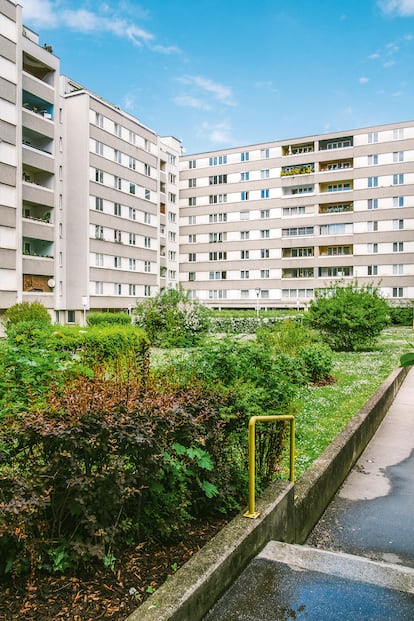
This situation “has disturbingly encouraged the property tenure regime, both in the free market and, surprisingly, in the protected or subsidized market.” Social housing represents a tiny 2.5% of Spanish real estate: some 290,000 houses, managed by regional governments (72%) and municipal governments (27%), as detailed in a 2020 report from Spain’s Ministry of Housing. This is well below the European average, which stands at 9%.
However, in recent months, the government of Prime Minister Pedro Sánchez has announced the construction of 183,000 social housing units, in what he described as a “strong commitment to building a public [housing system] similar to that of advanced European countries.” The Spanish public housing model has been characterized by “shrinking irrelevance,” according to Pedro Górgolas, “a strategy that differs from [the rest of] developed Europe.”
The oldest public housing development in the world is the Fuggerei, founded in 1521. It was built in Augsburg, Bavaria, by a wealthy merchant to shelter low-income people. At the end of the 19th century, however, this trend picked up across Europe. Spurred by industrialization, a global urban revolution took place, as thousands of peasants settled in the cities. The first contemporary social housing project was built in London. The Boundary Estate, opened in 1900, was completed by the London County Council, to improve life in the Shoreditch district in the East End of London. According to records from the end of the Victorian era, the district wasn’t plagued by insecurity, although it was a poor area, filled with low-quality houses. It also had a life expectancy rate that was half that of other areas of the British capital.
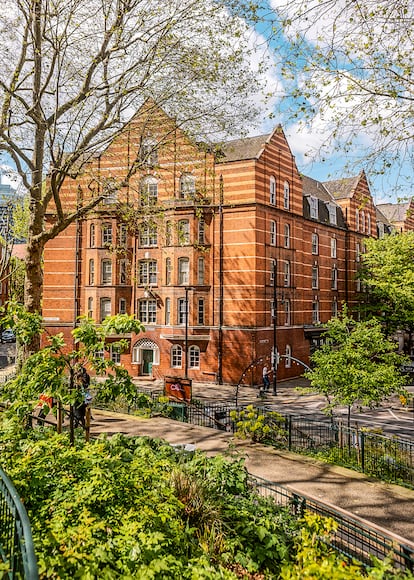
Designed by Owen Fleming, the Boundary Estate (which is still standing, though less than 10% of the property remains publicly owned) was seen as an improvement for the neighborhood. “At the beginning of the 20th century, poor habitability was already linked to the proliferation of diseases,” explains architect and urban planner José María Ezquiaga, former dean of the Madrid College of Architects. “This inspired a radical rethinking of architecture, the housing model and the city.”
“In Europe, in terms of housing, we are indebted to the revolution of the Bauhaus movement, the International Congresses of Modern Architecture and the Central European experiments in social housing,” Ezquiaga says. One such experiment took place in Stuttgart, Germany, in the summer of 1927: the Die Wohnung exhibition, which attracted 500,00 visitors. The highlight was a series of model houses designed by 16 pioneering architects: Mies van der Rohe, Ludwig Hilberseimer, Hans Poelzig, Max and Bruno Taut, Hans Scharoun, Adolf Rading, Richard Döcker and Adolf Gustav Schneck, Walter Gropius, Peter Behrens, Josef Frank, Victor Bourgeois, Le Corbusier, Jacobus Johannes Pieter Oud and Mart Stam.
The projects materialized in 17 model homes, which proposed a new direction and a relatively cheaper form of housing. The architects condensed previous architectural styles, consolidating common spaces and green areas. Natural light was identified as being of great importance, while cheaper, mass-produced materials were used. The value of efficiency was prioritized in the design. These qualities were eventually put into practice in the Karl-Marx-Hof apartments. The work was done by Austrian architect Karl Ehn, who was a student of Otto Wagner. Common areas take up most of the structure’s space (80%), where social life was meant to take place. This can be seen in other Western European structures that were built later in the century, such as Madrid’s El Ruedo.
While the first traces of housing policy in Spain occurred during the Second Republic — between 1931 and 1939 — the model was consolidated during Franco’s dictatorship (1939-75). Since the dawn of the 20th century, Spanish cities had attracted migrants from the countryside. The Civil War froze these flows, but in the 1950s, 1960s and 1970s, internal migration began again. “Between 1951 and 1975, around 12 million Spaniards — more than 40% of the population — changed residences, mostly due to migration from the countryside to the city, [which resulted in] the associated problem of shantytowns,” explains the journalist and writer Andrés Rubio.
By the end of the 1950s, millions of Spanish families were living beyond major cities, oftentime in informal houses without running water or electricity. The consolidation of these suburbs was the main urban challenge of the moment. The Franco dictatorship found the solution to the housing problem in Barcelona, in 1959, when the first National Urban Planning Congress was held. The gathering ended up rejecting the avant-garde, leaving aside European experiences of housing (or proper urban planning) and instead embracing Anglo-Saxon and American models, which were more focused on cultivating generational ownership. “Spain was one of the European territories that, during the last century, allowed itself to be influenced the most by Americanization,” points out Andrés Rubio, who considers his country to be “one of the most affected by the serious lack of regulation in the United States to manage land.”
Protected by Franco’s regime, some firms specialized in the construction of low-quality housing — first for rent and later for sale — on the outskirts of cities. “Although it wasn’t pointed out, these houses were largely oriented towards the working population,” says Catalan researcher Mercé Tatjer. For instance, between 1960 and 1970, three out of every 10 homes built in Barcelona were constructed on these sprawling developments. Tatjer points out that it was at this time that the housing model was consolidated: “Renting as a form of home ownership disappeared, in favor of [private ownership].”
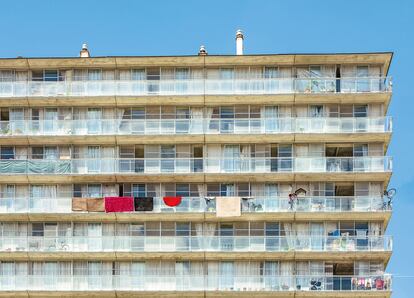
In contrast — and unlike many other capitals — Vienna has always resisted the privatization of public housing. The City Council has never yielded to pressure, which was especially strong in the late-1980s and early-1990s, to turn renters into owners. This was perhaps due to the awareness that, once the transactions were complete, the municipality would lose the ability to regulate rents. Thus, while the United Kingdom maintains almost 18% of its housing stock as public and France is close to 17%, the Netherlands leads with 30%, with Austria close behind, with one out of every four domiciles being publicly-owned. “In addition, social housing is distributed throughout all the districts [of Vienna],” points out Barbara Laa, a researcher specializing in urban planning at the Vienna University of Technology. “Compared to other cities, Vienna is quite mixed,” she stresses, referring to the socioeconomic diversity of the city’s neighborhoods. “Ghettos haven’t been created.” She feels that there has been a”solid and consistent” approach in public policies that — in addition to discouraging urban segregation — have helped control rental prices.
In Spain, between 2016 and 2021, rents went up by around 20% on average. Currently, all Spanish municipalities with more than 50,000 inhabitants are in their maximum rental price range, or very close to it. In this process of rising prices, the Spanish penchant for ownership has played a key role — it has turned the working class into what some experts call the “property infantry.” Since the 1960s, the Spanish population has increased by 55% — from around 30 million people to 48 million — while the supply of residences has increased by 225%, with there being up to 25,218,516 residential units, as stated by José Luis Campos in The Spanish Real Estate Bubble. The Spanish housing ratio is 537 per thousand inhabitants; the EU average stands at 452. Górgolas describes this as “a disturbing overproduction of housing, which has resulted in the underutilization of a significant percentage of the residential stock.”
“In addition, some residents — especially in self-built neighborhoods, in historic areas and in a good part of the private or public subdevelopments — now have to deal with homes that require heavy investment to adapt them to modern standards, or to meet the needs of their residents, who are aging,” sums up Mercé Tatjer.
French architect Anne Lacaton — who is part of the Lacaton & Vassal architecture studio — has the body of her work articulated around a single premise: “Never demolish.” “You have to renovate more and build less,” Lacaton argues. She inaugurated the 6th International Architecture Congress of Pamplona, Spain, titled, “The City We Want.”
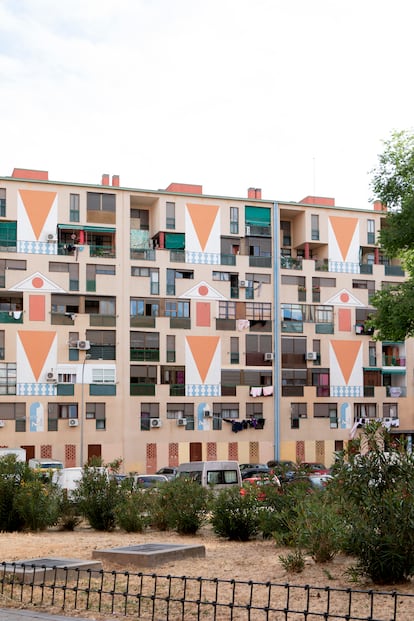
Among the most celebrated renovations done by Lacaton & Vassal is the remodelling of 530 apartments in a working-class neighborhood of Bordeaux, France — work that was awarded the European Union Prize for Contemporary Architecture in 2019. The architect couple tackled a social housing building erected in 1960, expanding the living space, increasing the amount of natural light and improving environmental efficiency. “The spaces where we live aren’t always adequate — a neighborhood or a city aren’t simply accumulations of elements that can be multiplied,” Lacaton affirms. She defends a housing model that is “high-quality, generous, affordable, [built for] diverse people who have different ways of life… these are essential conditions for creating a city.”
“Diversity, mixed uses, the use of shared spaces, sustainability and the rehabilitation of old infrastructure are the issues that housing design must take into account,” say Carmen Espegel, Andrés Cánovas and José María de Lapuerta, curators of Domestic Sunrises: Collective Housing Issues in 21st century Europe, an exhibition that was held at the ICO Foundation in Madrid last year. Espegel argues that “the tools applied in the 20th century to public housing projects have become obsolete.” For this reason, the curators identify a series of key areas to take into account when building today: climate awareness, care, new management models, the urban context and identities.
“Renewed momentum is emerging to increase investment in social housing,” states a 2020 report from the Organization for Economic Co-operation and Development (OECD). The study — Social Housing: A Key Part of Past and Future Housing Policy — also describes public housing as an efficient tool to alleviate the urban excesses of the last century and recover the link between architecture and housing. The French architect Lacaton sums this up with a phrase: “Housing is the most beautiful challenge of contemporary architecture.”
Sign up for our weekly newsletter to get more English-language news coverage from EL PAÍS USA Edition
Tu suscripción se está usando en otro dispositivo
¿Quieres añadir otro usuario a tu suscripción?
Si continúas leyendo en este dispositivo, no se podrá leer en el otro.
FlechaTu suscripción se está usando en otro dispositivo y solo puedes acceder a EL PAÍS desde un dispositivo a la vez.
Si quieres compartir tu cuenta, cambia tu suscripción a la modalidad Premium, así podrás añadir otro usuario. Cada uno accederá con su propia cuenta de email, lo que os permitirá personalizar vuestra experiencia en EL PAÍS.
¿Tienes una suscripción de empresa? Accede aquí para contratar más cuentas.
En el caso de no saber quién está usando tu cuenta, te recomendamos cambiar tu contraseña aquí.
Si decides continuar compartiendo tu cuenta, este mensaje se mostrará en tu dispositivo y en el de la otra persona que está usando tu cuenta de forma indefinida, afectando a tu experiencia de lectura. Puedes consultar aquí los términos y condiciones de la suscripción digital.
More information
Archived In
Últimas noticias
Most viewed
- Pablo Escobar’s hippos: A serious environmental problem, 40 years on
- Reinhard Genzel, Nobel laureate in physics: ‘One-minute videos will never give you the truth’
- Why we lost the habit of sleeping in two segments and how that changed our sense of time
- Charles Dubouloz, mountaineering star, retires at 36 with a farewell tour inspired by Walter Bonatti
- The Florida Keys tourist paradise is besieged by immigration agents: ‘We’ve never seen anything like this’

